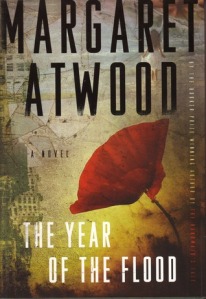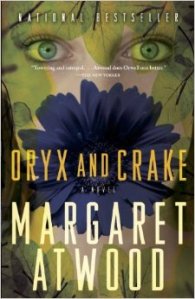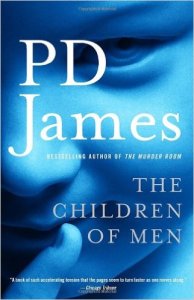Books discussed in this essay: The Handmaid’s Tale (Margaret Atwood; 1985); When She Woke (Hillary Jordan; 2011); “Evidence of Love in a Case of Abandonment” (M. Rickert; collected in Brave New Worlds, 2011); Daughters of the North (Sarah Hall; 2007). Major spoilers abound.
The dystopian novel is one with an agenda. It magnifies an issue in our society so that we can better examine it. The dystopian society–typically set in a future or alternate world–centers around that one issue, which is exaggerated often to the point of unbelievability. But this distortion is necessary so that we can clearly understand the impact.
A clear example is the popular Hunger Games trilogy, which focuses on the very current topic of income inequality. In one memorable scene, the elite of the Capitol gorge on rich food and then make themselves vomit so they can eat still more, while the citizens of the Districts go hungry. The scene is extreme, but that extremeness prompts the reader to think about the issue of food security and waste in our present unequal world.
 Feminist dystopias focus on women’s rights, which usually revolve around the thorny subject of reproduction. Becoming pregnant is one of the most private experiences a woman can have, but pregnancy and babies are among the most public of issues a society addresses. The society’s future is bound up in babies: how many, how healthy, are they the kind of babies we want? Since men have always been in charge of society, the issue of paternity–tied up in inheritance, class structure, and all manner of complexities–is also of foremost concern. It’s easy to determine who the mother of any child is, but only the mother knows who the father is (and sometimes not even then).
Feminist dystopias focus on women’s rights, which usually revolve around the thorny subject of reproduction. Becoming pregnant is one of the most private experiences a woman can have, but pregnancy and babies are among the most public of issues a society addresses. The society’s future is bound up in babies: how many, how healthy, are they the kind of babies we want? Since men have always been in charge of society, the issue of paternity–tied up in inheritance, class structure, and all manner of complexities–is also of foremost concern. It’s easy to determine who the mother of any child is, but only the mother knows who the father is (and sometimes not even then).
Society (and men) want to regulate when and how women become pregnant, whether they carry their babies to term, and who is fathering them. As a result, women’s bodies are considered public property, subject to legislation and regulation. Women themselves become objects rather than human beings, property that can be bought, sold, and bartered. Feminism often boils down to the conflict between society’s need to manage reproduction and a woman’s right to recognition as a person and to control her most personal possession–her own body.
 The alpha feminist dystopia, and still the foremost classic, is The Handmaid’s Tale. In Atwood’s seminal novel, fertility has decreased dramatically due to environmental degradation. Those women who are still fertile have been enslaved solely for the purpose of carrying the babies of the elite ruling class. Women have been deprived of all their rights, denied access to money and property, and separated from their families–all justified by the religious authority of this future society’s theocratic rulers. A “handmaiden” is literally required to have sex with her male owner while lying on top of his wife, so that the wife symbolically becomes impregnated with the oh-so-valuable baby.
The alpha feminist dystopia, and still the foremost classic, is The Handmaid’s Tale. In Atwood’s seminal novel, fertility has decreased dramatically due to environmental degradation. Those women who are still fertile have been enslaved solely for the purpose of carrying the babies of the elite ruling class. Women have been deprived of all their rights, denied access to money and property, and separated from their families–all justified by the religious authority of this future society’s theocratic rulers. A “handmaiden” is literally required to have sex with her male owner while lying on top of his wife, so that the wife symbolically becomes impregnated with the oh-so-valuable baby.
Obviously, Atwood is exaggerating for dramatic effect, but there is no denying the impact of this image. Her imagined society, Gilead, is an extreme but logical extension of ongoing attempts to control women and their reproduction based on religion. Atwood’s goal is not to get us to believe this could actually happen. Her goal is to get us recognize the insidiousness of religion in controlling people’s lives and to feel the utter deprivation of a woman denied control over her own body, to the point where it is considered the extension of the body of another woman and the property of a man.
Even more than thirty years after the publication of The Handmaid’s Tale, Atwood’s warning bell resonates with readers. In looking at the pattern of laws enacted in recent years in the United States to restrict and control pregnant women, it can often feel like we are already living in a version of Gilead. That’s why this story endures, and why it’s important to keep reading and rereading it.
 Jordan’s When She Woke is a direct descendant of The Handmaid’s Tale. This retelling of The Scarlet Letter takes place in a near-future, fundamentalist Christian dystopia where abortion has been outlawed as a result of widespread infertility. Those who are convicted of having abortions awake to find that their skin has been dyed a bright red color. These “Chromes” are released into society, where they face being ostracized, assaulted, and possibly murdered. Like The Handmaid’s Tale, When She Woke exaggerates the current trend of restricting and all but criminalizing the rights of pregnant women in the name of religion.
Jordan’s When She Woke is a direct descendant of The Handmaid’s Tale. This retelling of The Scarlet Letter takes place in a near-future, fundamentalist Christian dystopia where abortion has been outlawed as a result of widespread infertility. Those who are convicted of having abortions awake to find that their skin has been dyed a bright red color. These “Chromes” are released into society, where they face being ostracized, assaulted, and possibly murdered. Like The Handmaid’s Tale, When She Woke exaggerates the current trend of restricting and all but criminalizing the rights of pregnant women in the name of religion.
Rickert’s chilling short story “Evidence of Love in a Case of Abandonment” (collected in the John Joseph Adams-edited anthology Brave New Worlds) also envisions an America in which abortion has been outlawed. In this dystopia, women convicted of having abortions when they were still legal are publicly executed. The punishments meted out in these two dystopias for the crime of abortion may seem outlandish, but these authors are simply following the path of current legislation, where women considering having abortions are forced to undergo invasive procedures, inaccurate “counseling,” and other hoops designed to circumvent their ability to choose for themselves whether to be pregnant.
 Hall’s Daughters of the North (originally published in the United Kingdom as The Carhullan Army) examines the other side of the issue: the actions societies take when they need to reduce the number of babies being born. The end result still curtails women’s reproductive choice by directly controlling their bodies. In a future world decimated by economic and environmental disasters, where resources have become scarce, couples must apply for licenses to have children. All fertile women are required to have IUDs, and compliance may be checked at any time by any enforcement officer, in public, in a manner that is essentially sexual violence or near rape. The protagonist chooses to rebel, joining a commune of women who are training as guerilla fighters to resist this authoritarian regime.
Hall’s Daughters of the North (originally published in the United Kingdom as The Carhullan Army) examines the other side of the issue: the actions societies take when they need to reduce the number of babies being born. The end result still curtails women’s reproductive choice by directly controlling their bodies. In a future world decimated by economic and environmental disasters, where resources have become scarce, couples must apply for licenses to have children. All fertile women are required to have IUDs, and compliance may be checked at any time by any enforcement officer, in public, in a manner that is essentially sexual violence or near rape. The protagonist chooses to rebel, joining a commune of women who are training as guerilla fighters to resist this authoritarian regime.
 Human history has always been a dystopia for women, who as a group have never achieved full ownership of either their bodies or their lives. Women in Western democracies only gained the right to vote–an acknowledgement that women were actually people–during the last century. Sexual slavery, suttee, honor killings, genital mutilation, foot-binding — these are only a few of the horrors inflicted on women (and are still in practice in many places today).
Human history has always been a dystopia for women, who as a group have never achieved full ownership of either their bodies or their lives. Women in Western democracies only gained the right to vote–an acknowledgement that women were actually people–during the last century. Sexual slavery, suttee, honor killings, genital mutilation, foot-binding — these are only a few of the horrors inflicted on women (and are still in practice in many places today).
The struggle for women’s rights and freedom still rages in every part of the world, even in the supposedly developed West. In the United States alone, states have enacted over 200 laws restricting reproductive rights since 2010, a dramatic up-surge. Feminist dystopias remind us not to get comfortable or let our guards down, or we could all too easily lose those rights we struggled so long to obtain. A true feminist utopia, in which women are considered full people whose bodies belong only to them, still exists solely in the imagination of science fiction.
 In The Unit, Holmqvist takes us into a dystopian world that is more frightening because it seems so familiar. In this near-future or alternative society (it is never clear which), people who are deemed “dispensable” are confined to the unit, a dreamlike world where they have no wants unmet, while they are efficiently employed as subjects of dangerous experiments and their organs systematically harvested for the benefit of the “needed.” To not have children is the primary means of becoming dispensable, although they seem to be drawn from the ranks of artists, writers, and others who cannot conform to middlebrow society for one reason or another.
In The Unit, Holmqvist takes us into a dystopian world that is more frightening because it seems so familiar. In this near-future or alternative society (it is never clear which), people who are deemed “dispensable” are confined to the unit, a dreamlike world where they have no wants unmet, while they are efficiently employed as subjects of dangerous experiments and their organs systematically harvested for the benefit of the “needed.” To not have children is the primary means of becoming dispensable, although they seem to be drawn from the ranks of artists, writers, and others who cannot conform to middlebrow society for one reason or another. Each of these series posits such a transformation. In the
Each of these series posits such a transformation. In the 
 In the
In the 
 Feminist dystopias focus on women’s rights, which usually revolve around the thorny subject of reproduction. Becoming pregnant is one of the most private experiences a woman can have, but pregnancy and babies are among the most public of issues a society addresses. The society’s future is bound up in babies: how many, how healthy, are they the kind of babies we want? Since men have always been in charge of society, the issue of paternity–tied up in inheritance, class structure, and all manner of complexities–is also of foremost concern. It’s easy to determine who the mother of any child is, but only the mother knows who the father is (and sometimes not even then).
Feminist dystopias focus on women’s rights, which usually revolve around the thorny subject of reproduction. Becoming pregnant is one of the most private experiences a woman can have, but pregnancy and babies are among the most public of issues a society addresses. The society’s future is bound up in babies: how many, how healthy, are they the kind of babies we want? Since men have always been in charge of society, the issue of paternity–tied up in inheritance, class structure, and all manner of complexities–is also of foremost concern. It’s easy to determine who the mother of any child is, but only the mother knows who the father is (and sometimes not even then).  The alpha feminist dystopia, and still the foremost classic, is
The alpha feminist dystopia, and still the foremost classic, is  Jordan’s
Jordan’s  Hall’s
Hall’s  Human history has always been a dystopia for women, who as a group have never achieved full ownership of either their bodies or their lives. Women in Western democracies only gained the right to vote–an acknowledgement that women were actually people–during the last century. Sexual slavery, suttee, honor killings, genital mutilation, foot-binding — these are only a few of the horrors inflicted on women (and are still in practice in many places today).
Human history has always been a dystopia for women, who as a group have never achieved full ownership of either their bodies or their lives. Women in Western democracies only gained the right to vote–an acknowledgement that women were actually people–during the last century. Sexual slavery, suttee, honor killings, genital mutilation, foot-binding — these are only a few of the horrors inflicted on women (and are still in practice in many places today). 
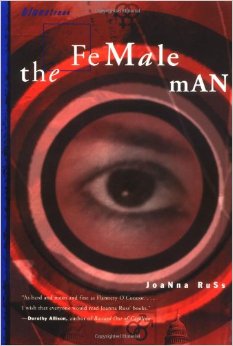 Four women from alternate universes come together in this work of feminist speculative fiction.
Four women from alternate universes come together in this work of feminist speculative fiction.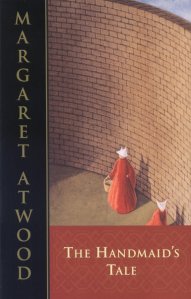 Consider, for instance, Atwood’s most well-known book, The Handmaid’s Tale (1985), which was nominated for the Booker Prize but won the Arthur C. Clarke Award the very first time it was given out. It is set in a dystopian future, in which the U.S. government has been taken over by Christian fundamentalists and a lot of basic rights have been stripped away. Due to extreme pollution, many people have become infertile. Those women who are fertile are enslaved as Biblical-style handmaids, conceiving and bearing children for wealthy, infertile women. Its dystopian, futuristic setting place it squarely in the science fiction tradition.
Consider, for instance, Atwood’s most well-known book, The Handmaid’s Tale (1985), which was nominated for the Booker Prize but won the Arthur C. Clarke Award the very first time it was given out. It is set in a dystopian future, in which the U.S. government has been taken over by Christian fundamentalists and a lot of basic rights have been stripped away. Due to extreme pollution, many people have become infertile. Those women who are fertile are enslaved as Biblical-style handmaids, conceiving and bearing children for wealthy, infertile women. Its dystopian, futuristic setting place it squarely in the science fiction tradition.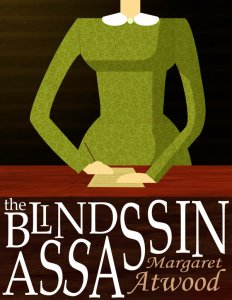 The Blind Assassin (2000), which won the Booker Prize, is not as straightforward in terms of genre, but it does contain science fiction elements. Its structure is very unusual, in that it is a novel within a novel within a novel. The framing structure is a straightforward historical novel about a wealthy Canadian family’s fall from grace during the Depression and World War II. Within this novel is an intertwined story of two unnamed lovers and their clandestine affair. During their meetings, the lovers — one of whom is a pulp writer — tell each other a bizarre fable that takes place on an alien planet, which underscores their unspoken feelings for each other. The fable, titled The Blind Assassin, is turned into a novel by one of the characters and develops a cult-like following. The intricate structure makes this an engrossing novel, but it is questionable whether it can be called science fiction. Regardless, Atwood is comfortable using tropes of the genre in exciting and unusual ways when it suits her.
The Blind Assassin (2000), which won the Booker Prize, is not as straightforward in terms of genre, but it does contain science fiction elements. Its structure is very unusual, in that it is a novel within a novel within a novel. The framing structure is a straightforward historical novel about a wealthy Canadian family’s fall from grace during the Depression and World War II. Within this novel is an intertwined story of two unnamed lovers and their clandestine affair. During their meetings, the lovers — one of whom is a pulp writer — tell each other a bizarre fable that takes place on an alien planet, which underscores their unspoken feelings for each other. The fable, titled The Blind Assassin, is turned into a novel by one of the characters and develops a cult-like following. The intricate structure makes this an engrossing novel, but it is questionable whether it can be called science fiction. Regardless, Atwood is comfortable using tropes of the genre in exciting and unusual ways when it suits her.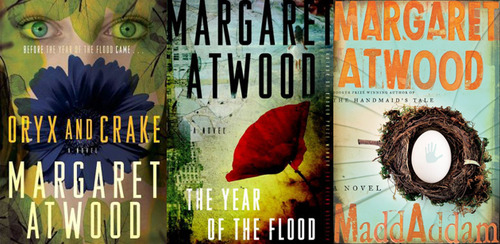 With her more recent
With her more recent 


